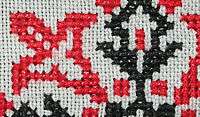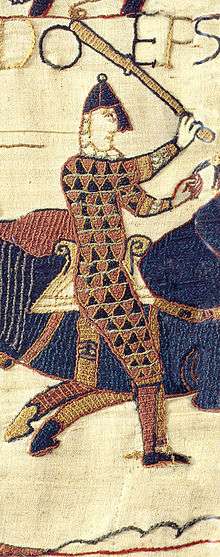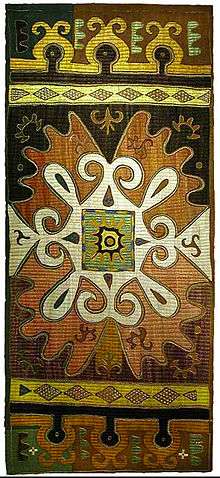Balanced fabric
A balanced fabric is one in which the warp and the weft are of the same size. In weaving, these are generally called "balanced plain weaves" or just "balanced weaves", while in embroidery the term "even-weave" is more common.

Balanced weave
A balanced plain weave is a fabric in which the warp threads and the weft threads are equally spaced, and are identical or similar in size.[1]:76 In addition to the same sett, the yarn is the same in the warp and weft.[2] The term can be used for a tabby weave[1]:86 or a basketweave.[1]:88
Balanced weaves have also been called "50/50 plain webs",[3] and are a subset of plain weaves. Unbalanced weaves, in which warp and weft differ in size, may be either warp-dominant or weft-dominant fabrics.[4] The primary advantage of balanced weaves is that they are potentially stronger than other basic weaves.[5]
Even-weave
An even-weave fabric or canvas, a term mostly used in embroidery, is any textile where the warp and weft threads are of the same size.[6][7] Even-weave fabrics include even-weave aida cloth, linen, and needlepoint canvas. These fabrics are typically required as foundations for counted-thread embroidery styles such as blackwork, cross-stitch, and needlepoint, so that a stitch of the same "count" (that is, crossing the same number of fabric threads) will be the same length whether it crosses warp or weft threads.
References
- Emery, Irene (1980). The Primary Structures of Fabrics: An Illustrated Classification. The Textile Museum.
- Sutton, Ann (1982). The Structure of Weaving. London: Hutchinson. p. 9. ISBN 0091495008.
- Black, Mary E. (1957). New Key to Weaving: A Textbook of Hand Weaving for the Beginning Weaver. New York: The Bruce Publishing Company. pp. 51–52. LCCN 57-12564.
- Mitchell, Syne (2015). Inventive Weaving on a Little Loom. Storey Publishing. p. 32. ISBN 9781603429726.
- "Textile - Basic weaves". Encyclopædia Britannica. Retrieved 20 March 2019.
- "Even Weave". The Textile Research Center. Retrieved 25 July 2019.
- Burnham, Dorothy (1980). Warp and Weft: A Textile Terminology. Toronto: Royal Ontario Museum. p. 1.
Bibliography
- Bath, Virginia Churchill (1979). Needlework in America. Viking Press. ISBN 0-670-50575-7.
- Caulfield, Sophia Frances Anne & Saward, Blanche C. (1885). The Dictionary of Needlework.
- Complete Guide to Needlework. Readers Digest Association. 1979. ISBN 0-89577-059-8.
External links
| Wikimedia Commons has media related to Cross-stitching. |
- "Embroidery fabric for counted thread projects". Needlework Tips and Techniques.



